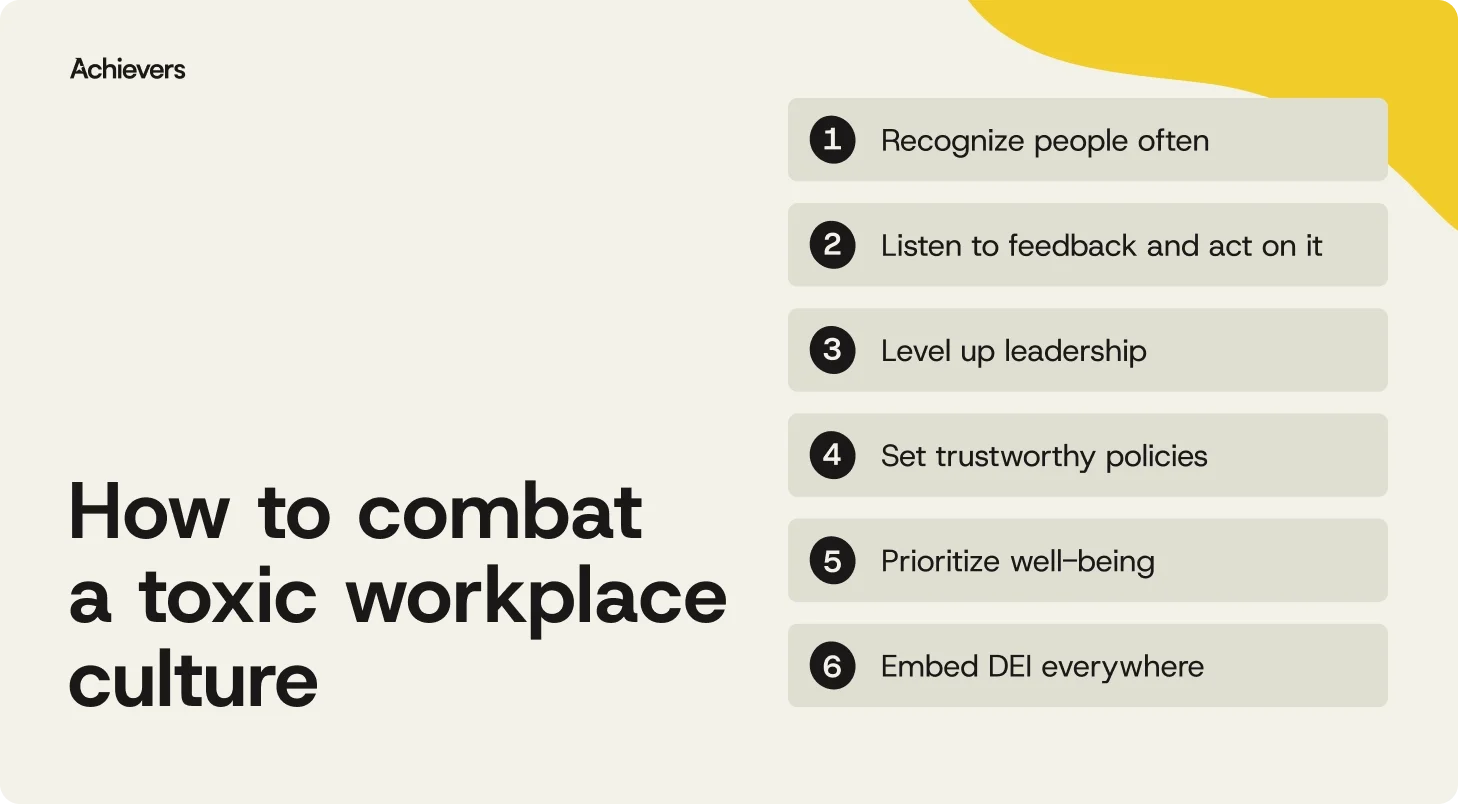Table of contents
A toxic work culture doesn’t always kick down the door — sometimes it just creeps in, disguised as chronic burnout, quiet apathy, or that sinking feeling before Monday meetings. And it’s more common than you’d think: according to APA’s 2024 Work in America survey, 15% of employees say their workplace is somewhat or very toxic.
The good news? Culture isn’t fixed — it’s changeable. And once you know what to look for, you can start turning things around.
If things feel off, don’t write it off — this guide is your starting point for spotting the signs, addressing the root causes, and reshaping your culture into something worth staying for.
Signs of a toxic work culture
Toxic work culture doesn’t always come with a flashing warning sign — but the symptoms are often hiding in plain sight. While every workplace has its quirks, these five red flags show up again and again:
- High turnover: When employees are constantly heading for the door, it’s not just bad luck. It’s a sign that something deeper — and cultural — is pushing them out.
- Chronic stress: Deadlines pile up, expectations are unclear, support is nowhere to be found — and suddenly, burnout becomes the baseline. If people are constantly overwhelmed, the culture’s likely part of the problem.
- Cliques and exclusion: When employees feel like they have friends at work, insights from Achievers Workforce Institute (AWI) tell us that’s a key driver behind their resiliency at work. So if the office feels more like high school than a healthy workplace, it’s time to take a closer look at what leadership is allowing — or encouraging — to thrive.
- Disengagement: When people stop caring, stop speaking up, and stop showing up with any energy, the culture may have quietly told them their contributions don’t matter.
- Lack of trust: If employees don’t believe what leaders say — or worse, don’t believe leaders will do the right thing — that mistrust infects everything from team dynamics to day-to-day decision-making.
Causes of toxic work cultures
Toxic cultures are built, brick by brick, by broken systems, unchecked behaviors, and leadership blind spots. Here’s what often fuels the fire:
- Poor leadership: Micromanagers, bullies, or ghost-like leaders who never provide direction? All roads lead to chaos. When leaders aren’t setting a clear, respectful tone, toxicity tends to take the wheel.
- Lack of recognition: When people feel invisible, it doesn’t take long for motivation to fade away. No one wants to go above and beyond for a company that barely notices when they do the bare minimum.
- Communication breakdowns: Whether it’s inconsistent messaging, backroom decisions, or selective transparency, unclear communication creates confusion — and resentment.
- Unsustainable workloads: Hustle culture hits hard — and it hits back. When expectations are sky-high, but support is missing, even top performers start to check out.
- Discrimination and bias: This one isn’t just toxic — it’s corrosive. Any workplace where unfair treatment is overlooked (or worse, accepted) is on a fast track to dysfunction and reputational damage.
- Inconsistent policies: When rules apply to some but not others, trust falls apart. Employees aren’t asking for perfection — they’re asking for fairness. And without it, culture crumbles.
6 ways to combat a toxic workplace culture
Here’s the upside: toxic culture isn’t permanent. It can be repaired and replaced with something stronger. With the right steps, you can rebuild trust, re-energize your team, and create the kind of workplace people feel good walking into.
It doesn’t happen overnight, but it starts with intention. Here are six ways to shift your culture in the right direction — one step at a time:

1. Recognize people often — and make it meaningful
Achievers knows firsthand that a little recognition goes a long way — and a lack of it goes even further in the wrong direction. Recognition isn’t just about praise. It’s how cultures are built, values are reinforced, and people stay motivated to show up and give a damn.
What to do:
- Make recognition a daily habit, not an annual event: The best cultures don’t save appreciation for performance reviews — they weave it into everyday interactions.
- Empower everyone to recognize, not just managers: Peer-to-peer recognition builds connection and spreads appreciation across silos and teams.
- Tie recognition to your core values: When employees are celebrated for behaviors that align with company goals, culture gets real and repeatable.
- Use a platform that meets people where they are: Recognition should live inside the tools your team already uses — like Slack, Teams, or your HRIS — not in some forgotten login.
- Balance points with purpose: Rewards matter, but so does a sincere “thank you” delivered at the right moment. The best programs offer both.
2. Listen to feedback and act on it
You can’t fix what you won’t hear. And nothing turns a culture toxic faster than asking for feedback and doing absolutely nothing with it. If employees are giving you their truth, the least you can do is prove it matters.
What to do:
- Send surveys with purpose and follow-through: Short, frequent check-ins help track how people really feel, not just how they act in meetings.
- Open anonymous channels for unfiltered input: Not everyone feels safe being candid, especially in toxic cultures. Tools like HR chatbots or digital feedback boxes help surface what’s not being said aloud.
- Share what you’re hearing — and what you’re doing about it: Feedback is a two-way street. Don’t just collect insights; report back and close the loop.
- Track feedback trends over time: Use an engagement platform to spot patterns early, before they spiral into bigger cultural issues.
3. Build better leaders, not just better managers
Your culture is only as healthy as your managers. If people are leaving in waves, it’s not because the work is too hard — it’s because the leadership is. Coaching and accountability aren’t just for employees.
What to do:
- Promote leaders who know how to lead people — not just projects: Emotional intelligence, empathy, and communication skills should carry just as much weight as KPIs.
- Coach managers to coach others: Ditch the micromanagement. Teach leaders to empower, not control.
- Make 360° feedback the norm, not the exception: If you’re not asking employees how their managers are doing, you’re missing half the picture.
- Recognize and reward great leadership: Just like frontline employees, managers need reinforcement when they model the behaviors you want repeated.
4. Set clear, consistent policies everyone can trust
If your policies feel like they were written in 2003 — or apply differently depending on who’s asking — you’re not setting expectations. You’re sowing confusion. Employees need to know where the lines are and that they’re the same for everyone.
What to do:
- Audit your policies for clarity, relevance, and fairness: If a policy doesn’t make sense in today’s work environment, it’s time for an update.
- Apply policies consistently across the board: When exceptions become the rule for certain teams or leaders, trust erodes fast.
- Train managers to interpret and enforce policies correctly: Even the clearest handbook is useless if leaders aren’t aligned on what it says.
- Refresh your policies regularly — and communicate transparently: Culture shifts. So should your playbook.
5. Make employee wellness a cultural standard
If “wellness” at your company means a meditation app and no one actually takes vacation — it’s not working. Toxic cultures thrive in overwork. A healthy culture builds in room to breathe.
What to do:
- Staff to match workload — not wishful thinking: No one can thrive under constant pressure and unrealistic timelines.
- Make flexible work more than a buzzword: Flex hours, mental health days, and remote options shouldn’t feel like favors — they should be part of your foundation.
- Support well-being with real resources: EAPs, coaching, stress management tools — they all send the message that health matters here.
- Expect leaders to walk the talk: If your CEO is bragging about working weekends, don’t be surprised when burnout shows up in the engagement scores.
6. Embed DEI into every part of your culture
DEI isn’t an initiative. It’s a cultural immune system. If you’re not actively building equity, inclusion, and representation into the way your organization works, you’re leaving the door wide open to toxicity.
What to do:
- Embed DEI throughout the employee lifecycle: From hiring to promotion to recognition — equity should never be an afterthought.
- Hold leaders accountable for representation and belonging: Make DEI part of their performance expectations — not just their LinkedIn bios.
- Celebrate differences with intention, not just decoration: Real inclusion shows up in policies, practices, and paychecks — not just Pride Month posts.
- Offer ongoing, behavior-based DEI training: Awareness is a starting point. Equip your team to recognize bias and respond to it — every time.
Recognition: An antidote to toxic work culture
Toxic cultures don’t thrive on bad intentions — they thrive on neglect, inconsistency, and silence. Recognition interrupts all of that. And with Achievers, a recognition platform becomes a strategic tool for building trust, clarity, and connection across the organization.
Here’s how Achievers helps shift culture in the right direction:
- It counters disengagement with real-time appreciation: Apathy is fuel for a toxic culture. With more than 2x the recognition frequency of other providers, Achievers makes it easy to celebrate contributions as they happen — keeping employees connected, motivated, and seen.
- It builds psychological safety through visibility and inclusion: When everyone can recognize and be recognized — across roles, levels, and locations — it creates a sense of belonging. Achievers’ global platform supports recognition in 200+ languages and across 190 countries, helping ensure no one’s left out.
- It reinforces fairness and transparency: Recognition tied to company values sets a transparent, shared standard for what good looks like. With Achievers, every employee sees which behaviors are being celebrated — and how their own efforts align.
- It empowers leaders to lead better: Achievers delivers built-in prompts, nudges, and real-time insights to help managers recognize consistently, spot gaps, and model trust-building behaviors — not fear-based ones.
- It creates a daily feedback loop that’s rooted in values: Toxic cultures often lack meaningful communication. Achievers turns recognition into a two-way dialogue, reinforcing the values that matter most and helping leaders track how culture is really showing up across teams.
Don’t let toxic work culture take root
Toxic work culture doesn’t announce itself with a memo — it shows up in turnover, burnout, and silent Zoom calls. And once it takes root, the damage spreads fast: performance dips, trust erodes, and your best people start quietly checking out.
The good news? Culture isn’t fixed — it’s shaped. And the choices you make today can shift your organization toward something stronger, healthier, and more human. That means recognizing the right behaviors, listening with intent, investing in leadership, and building a workplace where people feel safe, seen, and supported.
Because when people thrive, business follows. And when culture works, everything else starts to fall into place.



